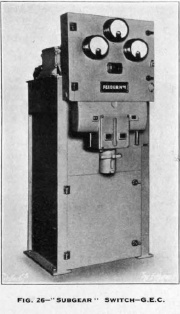Difference between revisions of "GEC: Electricity Generation and Transmission"
| Line 44: | Line 44: | ||
* [[GEC Transformers]] including the relevant parts of [[GEC]], [[AEI]] and [[English Electric Co]], and [[Hackbridge and Hewittic Electric Co]], [[Bryce Electric Construction Co|Bryce Capacitors]], [[Hackbridge and Hewittic Electric Co|Hackbridge-Hewittic and Easun]]. | * [[GEC Transformers]] including the relevant parts of [[GEC]], [[AEI]] and [[English Electric Co]], and [[Hackbridge and Hewittic Electric Co]], [[Bryce Electric Construction Co|Bryce Capacitors]], [[Hackbridge and Hewittic Electric Co|Hackbridge-Hewittic and Easun]]. | ||
* [[English Electric-AEI Turbine Generators|English Electric-AEI Turbines]] | * [[English Electric-AEI Turbine Generators|English Electric-AEI Turbines]] | ||
* | * [[English Electric-AEI Machines]], incorporating the machine activities of AEI and English Electric | ||
* | * [[English Electric-AEI Traction]], incorporating the traction activities of AEI and Englishe Electric and including [[AEI-GRS|AEI General Signals]] | ||
* | * [[English Electric-Hewittic Rectifiers]] including the rectifier activities of English Electric and Hackbridge and Hewittic Rectifiers; also responsible for [[Bertram Thomas]] | ||
* | * [[Micanite and Insulators]], including [[F. F. Chrestien]], [[Richard Whiffen]], [[J. T. Rothwell and Co|J. T. Rothwell]], [[Birlec]], Heavy Electricals (India), | ||
[[GEC]] had 9 other product divisions including 6 foundries | [[GEC]] had 9 other product divisions including 6 foundries | ||
Revision as of 11:43, 25 February 2020


Note: This is a sub-section of GEC
1914 Undertook complete central station equipment [1]
1918 GEC acquired the ordinary shares in Chamberlain and Hookham, meter manufacturers, and the turbine works of Fraser and Chalmers[2].
Post-war purchase of some small companies, such as Fraser-Chalmers Turbine Co, enabled GEC to attack the markets for heavy plant at very low prices.
1930 Development of high voltage switchgear and higher rated transformers for the National Grid. Contracts for the Manchester-Altrincham electrification and other railway projects; orders for ships with electrified propulsion[3].
1939 GEC's Witton factory was keeping pace with developments in transformers, faster-acting switch gear and traction equipment. Railway electrification business was won, both at home and abroad. Siemens and General Electric Railway Signal Co had experienced a busy year[4].
1955 One of four industrial groups formed to exploit the information being made available by UKAEA on design of nuclear power "furnaces" - GEC and Simon-CarvesLtd[5].
1956 GEC-Simon Carves Atomic Energy Group received the order for one of 3 nuclear power stations (at Hunterston) ordered by the Central Electricity Authority. GEC was to be main contractor[6].
1959 After discussions between GEC-Simon-Carves Ltd-Atomic Power Group and Atomic Power Constructions Ltd, the 2 groups agreed to collaborate on the design and construction of nuclear power stations. The two groups would submit joint tenders for the Dungeness power station[7].
1965[8]. As a response to the CEGB's policy of restricting orders for turbo-generators to just two designs (when there were 4 manufacturers), C. A. Parsons and Co bought the turbo-generator business of GEC[9]
1967 GEC acquired Associated Electrical Industries (AEI). The GEC Switchgear business brought together the corresponding businesses from the 2 companies; GEC Switchgear and AEI: Switchgear were rapidly integrated. The combined transformer business would be concentrated at AEI's Wythenshawe factory. AEI Turbine Generators had won 2 large orders from USA, one involving gas turbines that would be built at Trafford Park; there were also orders from UK and marine orders (GEC was the only UK manufacturer of geared steam turbine propulsion systems). AEI Large Electrical Machines had suffered from a lack of orders[10]
1968 GEC merged with the English Electric Co. This merger would give "The General Electric and English Electric Companies Limited" almost exactly half of the turbo-generator business. On 6th September the two companies issued a joint statement announcing that ‘a total merger should be effected between them ... under the chairmanship of Lord Nelson with Arnold Weinstock as managing director’.
1969 GEC Power Engineering was formed which included[11]:
- GEC Switchgear including the relevant parts of GEC, AEI and English Electric Co, and J. G. Statter and Co and Switchgear and Cowans
- GEC Transformers including the relevant parts of GEC, AEI and English Electric Co, and Hackbridge and Hewittic Electric Co, Bryce Capacitors, Hackbridge-Hewittic and Easun.
- English Electric-AEI Turbines
- English Electric-AEI Machines, incorporating the machine activities of AEI and English Electric
- English Electric-AEI Traction, incorporating the traction activities of AEI and Englishe Electric and including AEI General Signals
- English Electric-Hewittic Rectifiers including the rectifier activities of English Electric and Hackbridge and Hewittic Rectifiers; also responsible for Bertram Thomas
- Micanite and Insulators, including F. F. Chrestien, Richard Whiffen, J. T. Rothwell, Birlec, Heavy Electricals (India),
GEC had 9 other product divisions including 6 foundries
1972 English Electric-AEI Turbines received support for a project from government programme for the machine tool industry [12]
See also:
1988 Acquired Long and Crawford, which had about half of the British market for secondary distribution switchgear, from Cope Allman [13].
1989 GEC Alsthom was formed as a 50/50 joint venture by the merger of the power and transport divisions of Compagnie Générale d'Electricité (CGE) and GEC. From CGE's point of views, France’s market was not sufficient by itself so the merger would enable GEC Alsthom to address the whole of Europe. From GEC's point of view it provided GEC's power division with access to large gas turbine technology (which it had previously been licensing from GE of the U.S.A. and which was increasingly demanded by the privatised electricity companies in the UK and elsewhere).
See Also
Sources of Information
- ↑ 1914 Whitakers Red Book
- ↑ The Times, 9 July 1918
- ↑ The Times, 26 June 1930
- ↑ The Times, 30 June 1939
- ↑ The Times, 17 March 1955
- ↑ The Times, 14 December 1956
- ↑ The Times, 25 September 1959
- ↑ The Times, 22 February 1969
- ↑ The Times, 27 May 1968
- ↑ The Times July 30, 1968
- ↑ The Times, 10 January 1969
- ↑ The Times, Mar 15, 1972
- ↑ The Times, August 06, 1988















